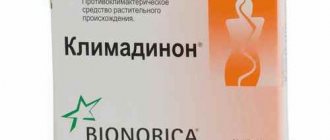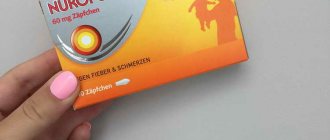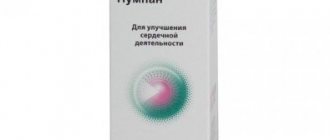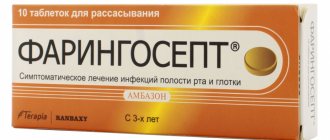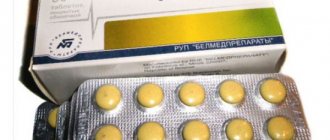Pharmacodynamics and pharmacokinetics
Corvaltab tablets, due to the properties of the active ingredients, have a calming effect , help reduce the excitability of the central nervous system and facilitate the process of falling asleep. Antispasmodic and sedative effects, similar to the effects of valerian extract , are inherent in the ethyl ester of α-bromoisovaleric acid , which is part of Corvaltab, which, when taken in large doses, also exhibits an unexpressed hypnotic effect . The sedative and vasodilating effect of phenobarbital manifests itself in small doses and turns into a hypnotic when taking higher doses. All this is supported by the antispasmodic and reflex vasodilating effects of mint oil.
Release form and composition
Corvaltab is produced in the form of tablets: round, flat, chamfered, almost white or white with inclusions, with a specific odor (10 pieces in blisters, 2 or 10 blisters in a cardboard box).
1 tablet contains the following active ingredients:
- Phenobarbital – 7.5 mg;
- Alpha-bromoisovaleric acid ethyl ester – 8.2 mg;
- Peppermint oil – 0.58 mg.
Auxiliary components: magnesium stearate, microcrystalline cellulose, potato starch, beta-cyclodextrin, lactose monohydrate.
Indications for use
Indications for taking Corvaltab are:
- increased excitability ;
- neuroses with symptoms of increased irritability;
- insomnia , as well as disturbances in the process of falling asleep;
- tachycardia;
- cardiopsychoneurosis;
- spasm of coronary vessels (mild);
- arterial hypertension at an early stage of development;
- spasms of the gastrointestinal tract, provoked by disorders of the neurovegetative system.
special instructions
During treatment, drinking alcohol should be avoided.
Phenobarbital, which is part of Corvaltab, may lead to the risk of developing Stevens-Johnson and Lyell syndrome (most likely in the first weeks of use).
Long-term therapy is not recommended, since long-term use of the drug can cause drug dependence, accumulation of bromine in the body and, as a result, poisoning.
If pain in the heart area does not go away after taking Corvaltab, you should consult a doctor to rule out acute coronary syndrome.
Corvaltab can cause dizziness and drowsiness, therefore, during therapy, patients are not recommended to work with dangerous mechanisms, drive vehicles and perform work that requires quick motor and mental reactions and increased attention.
Side effects
As a rule, the drug is quite well tolerated by patients.
drowsiness , mild dizziness allergic skin reactions may occur .
These phenomena are not permanent and usually disappear when the dose is reduced; it is extremely rare that a temporary cessation of taking pills is required.
In the case of taking high doses for a long time, the development of bromism .
Corvaltab tablets, instructions for use
The instructions for Corvaltab recommend taking the tablets orally before meals.
The selection of daily doses, as well as the duration of the treatment itself, should be determined only by a doctor and carried out individually.
As a rule, adults (over 18 years of age) are recommended to take 1-2 tablets two or three times (preferably with equal intervals) throughout the day.
In the case of treatment of spasms of coronary vessels, as well as treatment of tachycardia , the single dose can be increased to 3 tablets.
Korvaltab Extra tablets No. 20 in Nur-Sultan
Instructions for medical use of the drug
Corvaltab Extra
Trade name Corvaltab Extra
International Nonproprietary Name No
Dosage form Film-coated tablets
Composition One tablet contains the active ingredients: guaifenesin 100 mg, doxylamine hydrogen succinate 3.5 mg, α-bromoisovaleric acid ethyl ester 8.2 mg; excipients: mint oil, β-cyclodextrin, maltodextrin, copovidone, crospovidone, silicon dioxide (colloidal hydrophobic), colloidal silicon dioxide aqueous, magnesium stearate; Opadry II White shell composition: polyethylene glycol, polyvinyl alcohol, talc, titanium dioxide (E 171).
Description Round tablets with a biconvex surface, white film-coated, with a specific odor.
Pharmacotherapeutic group Other hypnotics and sedatives. ATX code N05SM
Pharmacological properties Pharmacokinetics Guaifenesin is quickly (after 30 minutes) absorbed from the gastrointestinal tract. Predominantly penetrates into tissues containing acidic mucopolysaccharides. After oral administration, the maximum concentration is reached after 1-2 hours, and the therapeutic concentration is maintained for 6 hours. The half-life of guaifenesin is about 1 hour. It is excreted in sputum and excreted by the kidneys in the form of metabolites, as well as in an unchanged state. The maximum concentration of doxylamine hydrogen succinate in the blood plasma (Cmax) is achieved on average 2 hours (Tmax) after taking the drug. The average half-life of doxylamine from blood plasma (T½) is on average 10 hours. Doxylamine hydrogen succinate is partially metabolized in the liver by demethylation and N-acetylation. The half-life may be significantly longer in the elderly and in patients with renal or hepatic impairment. The various metabolites produced by the breakdown of the molecule are not quantitatively significant, since 60% of the dose taken is found in the urine in the form of unchanged doxylamine. Pharmacodynamics Vasodilator (coronarolytic), sedative, hypnotic. Has a mild antianginal effect. Helps reduce the excitability of the central nervous system, has a calming effect and facilitates the onset of natural sleep. Ethyl ester of α-bromoisovaleric acid, which is part of the drug, has antispasmodic, coronary and sedative effects; in large doses it also causes a mild hypnotic effect. Guaifenesin has an anxiolytic (anti-anxiety) effect. Doxylamine hydrogen succinate is a blocker of H1-histamine receptors and exhibits sedative, hypnotic and antiallergic effects.
Indications for use Mild spasms of the coronary vessels; neurocirculatory dystonia – in complex therapy; neuroses with increased irritability; increased excitability; mild form of insomnia; dermatoses accompanied by itching.
Method of administration and dosage The dosage and duration of the course of treatment are established by the doctor individually for each patient. Adults are usually prescribed 1 tablet of the drug 2-3 times a day before meals. For mild insomnia, take 1-2 tablets 30 minutes before bedtime.
Side effects In some cases, the following side effects may be observed: from the nervous system: drowsiness, slight dizziness; from the digestive tract: nausea, vomiting; from the immune system: allergic reactions (including skin rash, itching, urticaria). These phenomena disappear when the dose is reduced or the drug is stopped. With prolonged use of large doses of the drug, the development of bromism is possible. Diarrhea, constipation, dry mouth, impaired accommodation, palpitations. Daytime drowsiness: If this effect develops, the dose should be reduced. There are rare reports of bladder or kidney stones in patients taking large amounts of guaifenesin for a long time. If undesirable side reactions occur, you should consult a doctor.
Contraindications - hypersensitivity to the components of the drug or to antihistamines - severe renal and liver dysfunction, hepatic porphyria - closed-angle glaucoma in the patient's medical history or family history - urethroprostatic disorders with a risk of urinary retention - severe heart failure - depression and other disorders accompanied by depression activity of the central nervous system - children under 18 years of age
Drug interactions When the drug is used simultaneously with other drugs that depress the central nervous system, mutual enhancement of the effect, as well as an increase in the effect of ethanol, is possible. The effect of the drug is enhanced by drinking alcohol. It should be taken into account that when using a combination of the drug with: - atropine and atropine-like drugs (imipramine antidepressants, anticholinergic antiparkinsonian drugs, atropine antispasmodic drugs, disopyramide, phenothiazine neuroleptics), side effects such as urinary retention, constipation, dry mouth may occur ; - antidepressants, morphine derivatives (painkillers and drugs used to treat cough), antipsychotics; barbiturates, benzodiazepines, and centrally acting antihypertensives may increase depression of the central nervous system.
Special instructions While taking the drug, you should avoid drinking alcohol. Should be used with caution in elderly patients due to the risk of dizziness. During treatment with the drug, sleep apnea syndrome may worsen (increase in the number and duration of breathing stops). In some cases, a change in the color of urine may occur. The drug should be used with caution in the following categories of patients: • with chronic or continuous cough caused by asthma, smoking, chronic bronchitis and emphysema; • with impaired renal function; • with myasthenia gravis; • with acute gastrointestinal disorders. Use during pregnancy or breastfeeding. The drug is not prescribed to pregnant women and women during breastfeeding. Features of the effect of the drug on the ability to drive a vehicle or potentially dangerous mechanisms During the period of treatment, you should refrain from driving a car or working with other mechanisms that require rapid psychomotor reactions.
Overdose Symptoms: possible drowsiness, weakness, dizziness, vertigo, gastrointestinal disorders and signs of anticholinergic effects: agitation, dilated pupils, accommodation paralysis, dry mouth, redness of the face and neck, hyperthermia, sinus tachycardia. Very high doses may cause symptoms such as agitation, confusion and respiratory depression. Treatment: discontinuation of the drug, gastric lavage and symptomatic therapy. There is no specific antidote.
Release form and packaging 10 tablets each in a blister pack made of aluminum foil and printed varnished aluminum foil. 1 or 2 blister packs together with instructions for medical use in the state and Russian languages are placed in a cardboard box.
Storage conditions Store in original packaging at a temperature not exceeding 25 ºС. Keep out of the reach of children!
Conditions for dispensing from pharmacies By prescription
Manufacturer/Registration Certificate Holder LLC “Pharma Start”, Ukraine, Kyiv
Interaction
When taken in combination with other drugs that depress the central nervous system , a two-way increase in effects is observed.
The effect of the drug, when taken together with alcohol and valproic acid , increases.
Against the background of the action of Corvaltab, it is possible to weaken the effects of Griseofulvin , glucocorticoids , coumarin derivatives, oral contraceptives and increase the toxicity of Methotrexate .
Analogs
Level 4 ATC code matches:
Corvalol
Belloid
Corvaldin
Bellaspon
Bellataminal
Reladorm
Valocordin
- Barboval;
- Valocordin;
- Valecard;
- Corvaldin;
- Corvalcaps , etc.
Reviews about Corvaltab
In almost all cases of using Corvaltab, reviews of its effectiveness are positive. The drug copes well with its intended purpose and, in very rare cases, leads to minimal side effects. The undoubted advantage of this drug is its price and dosage form in the form of tablets, which, along with drugs of similar action, such as Valocordin or Barboval in the form of drops, sets it apart in terms of speed and ease of administration.
Contraindications
- Hepatic porphyria;
- Severe functional disorders of the kidneys and/or liver;
- Severe heart failure;
- Children's age (due to the lack of experience with the use of Corvaltab in this age group of patients);
- Hypersensitivity to the components of the drug.
Medicines containing phenobarbital are contraindicated for use in diabetes mellitus, acute myocardial infarction, severe arterial hypotension, depression, alcoholism, myasthenia gravis, drug and drug addiction, obstructive syndrome, respiratory diseases with shortness of breath.
Corvaltab is not prescribed to lactating and pregnant women.
Since the drug contains lactose, patients with hereditary lactose-galactose intolerance are not recommended to take it.
Corvaltab should be taken with caution in patients with arterial hypotension, hyperkinesis, hyperthyroidism, adrenal hypofunction, acute and persistent pain, and acute drug intoxication.
Corvaltab price, where to buy
The price of the drug in Ukraine is No. 20 - 16 hryvnia and No. 100 - 75 hryvnia.
The estimated cost of the medicine in Russia is 60 rubles for 20 tablets.
- Online pharmacies in UkraineUkraine
- Online pharmacies in KazakhstanKazakhstan
Pharmacy24
- Korvaltab Extra No. 20 tablets Pharma Start TOV, Ukraine
35 UAH.order - Corvaltab No. 100 tablets Pharma Start TOV, Ukraine
90 UAH order
- Corvaltab No. 20 tablets Pharma Start TOV, Ukraine
18 UAH order
- Corvaltab Extra No. 10 tablets Pharma Start TOV, Ukraine
20 UAH order
PaniPharmacy
- Corvaltab tablets Corvaltab tablets. No. 100 Ukraine, Pharma Start LLC
105 UAH order
- Corvaltab extra tablets Corvaltab Extra tablets No. 10 Ukraine, Pharma Start LLC
24 UAH order
- Corvaltab extra tablets Corvaltab Extra tablets No. 20 Ukraine, Pharma Start LLC
38 UAH order
- Corvaltab tablets Corvaltab tablets. No. 20 Ukraine, Pharma Start LLC
20 UAH order
show more

